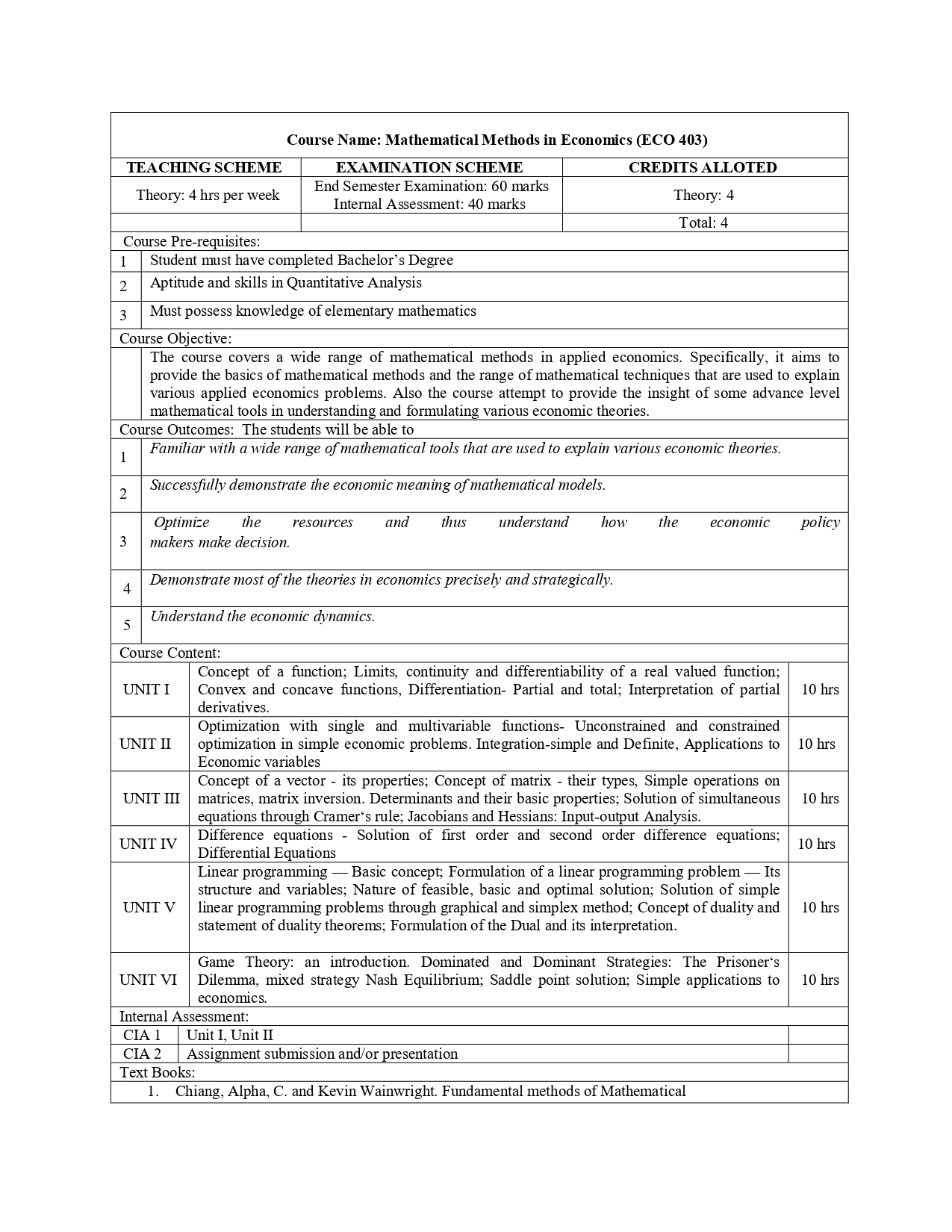
|
Course Objective: |
||
|
|
The course covers a wide range of mathematical methods in applied economics. Specifically, it aims to provide the basics of mathematical methods and the range of mathematical techniques that are used to explain various applied economics problems. Also the course attempt to provide the insight of some advance level mathematical tools in understanding and formulating various economic theories. |
|
|
Course Outcomes: The students will be able to |
||
|
1 |
Familiar with a wide range of mathematical tools that are used to explain various economic theories. |
|
|
2 |
Successfully demonstrate the economic meaning of mathematical models. |
|
|
3 |
Optimize the resources and thus understand
how the economic policy |
|
|
4 |
Demonstrate most of the theories in economics precisely and strategically. |
|
|
5 |
Understand the economic dynamics. |
|
|
Course Content: |
||
|
UNIT I Concept of a function; Limits, continuity and differentiability of a real valued function; Convex and concave functions, Differentiation- Partial and total; Interpretation of partial derivatives. |
10 hrs |
|
|
UNIT II Optimization with single and multivariable functions- Unconstrained and constrained optimization in simple economic problems. Integration-simple and Definite, Applications to Economic variables |
10 hrs |
|
|
UNIT III Concept of a vector - its properties; Concept of matrix - their types, Simple operations on matrices, matrix inversion. Determinants and their basic properties; Solution of simultaneous equations through Cramer‘s rule; Jacobians and Hessians: Input-output Analysis. |
10 hrs |
|
|
UNIT IV Difference equations - Solution of first order and second order difference equations; Differential Equations |
10 hrs |
|
|
UNIT V Linear programming — Basic concept; Formulation of a linear programming problem — Its structure and variables; Nature of feasible, basic and optimal solution; Solution of simple linear programming problems through graphical and simplex method; Concept of duality and statement of duality theorems; Formulation of the Dual and its interpretation. |
10 hrs |
|
|
UNIT VI Game Theory: an introduction. Dominated and Dominant Strategies: The Prisoner‘s Dilemma, mixed strategy Nash Equilibrium; Saddle point solution; Simple applications to economics. |
10 hrs |
|
|
Text Books: |
||
|
1. Chiang, Alpha, C. and Kevin Wainwright. Fundamental methods of Mathematical |
||
|
Reference Books: |
||
|
1. Economics, latest edition, McGraw Hill. |
||
|
2. Knut Sydsaeter and Peter J Hammond. Mathematics for Economic Analysis, Pearson Education India. |
||
|
3. Carl P Simon and Lawrence Blume. Mathematics for Economists, W. W. Norton & Company. |
||
|
4. Mike Rosser. Basic Mathematics for Economists, Routledge |
||
|
5. Eric Rasmusen. Games and Informations, Basil Blackwell. |
||
|
6. Martin, J Osborne. An Introduction to Game Theory, Oxford University Press |
||
- Teacher: Department of Economics